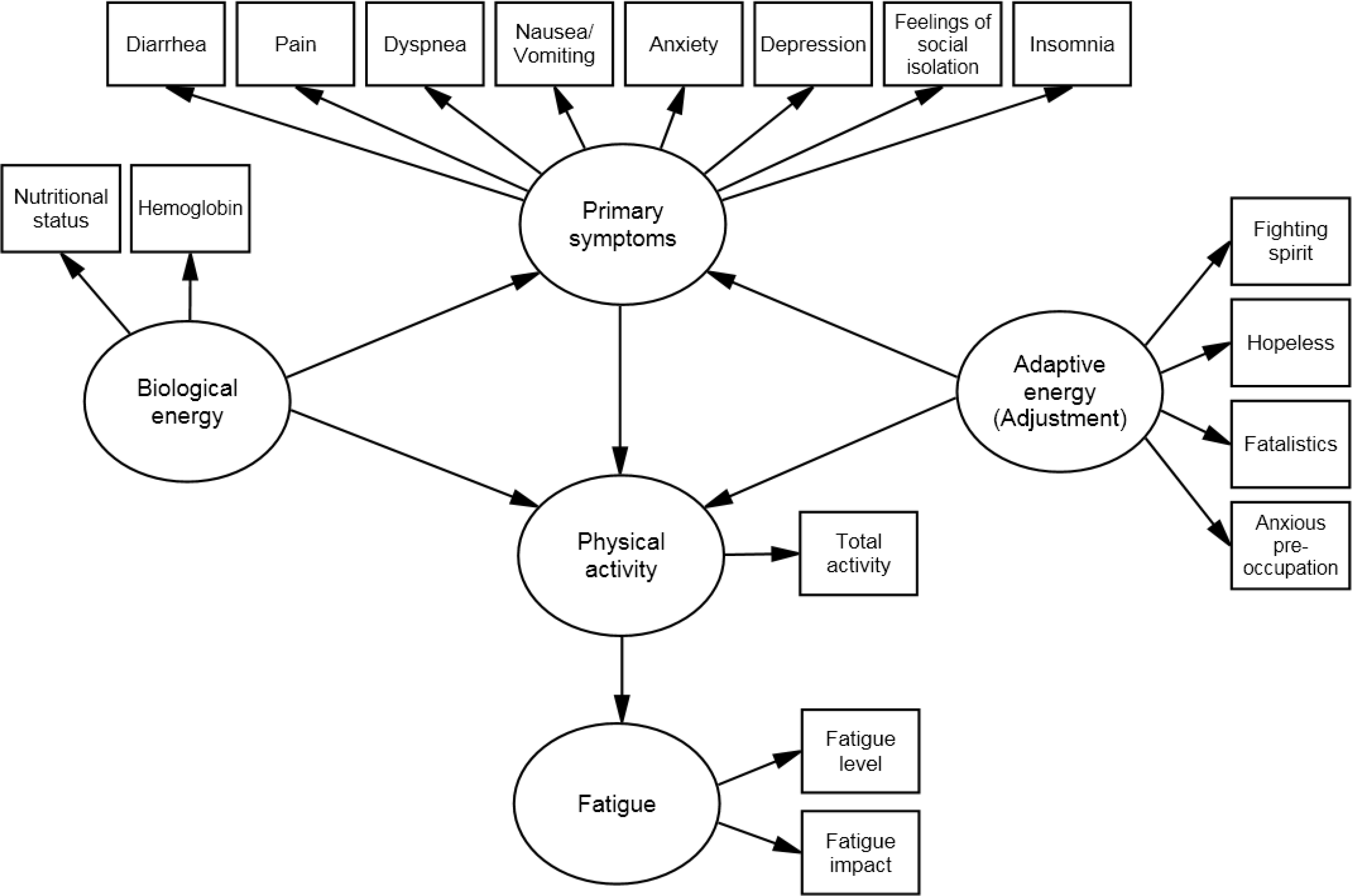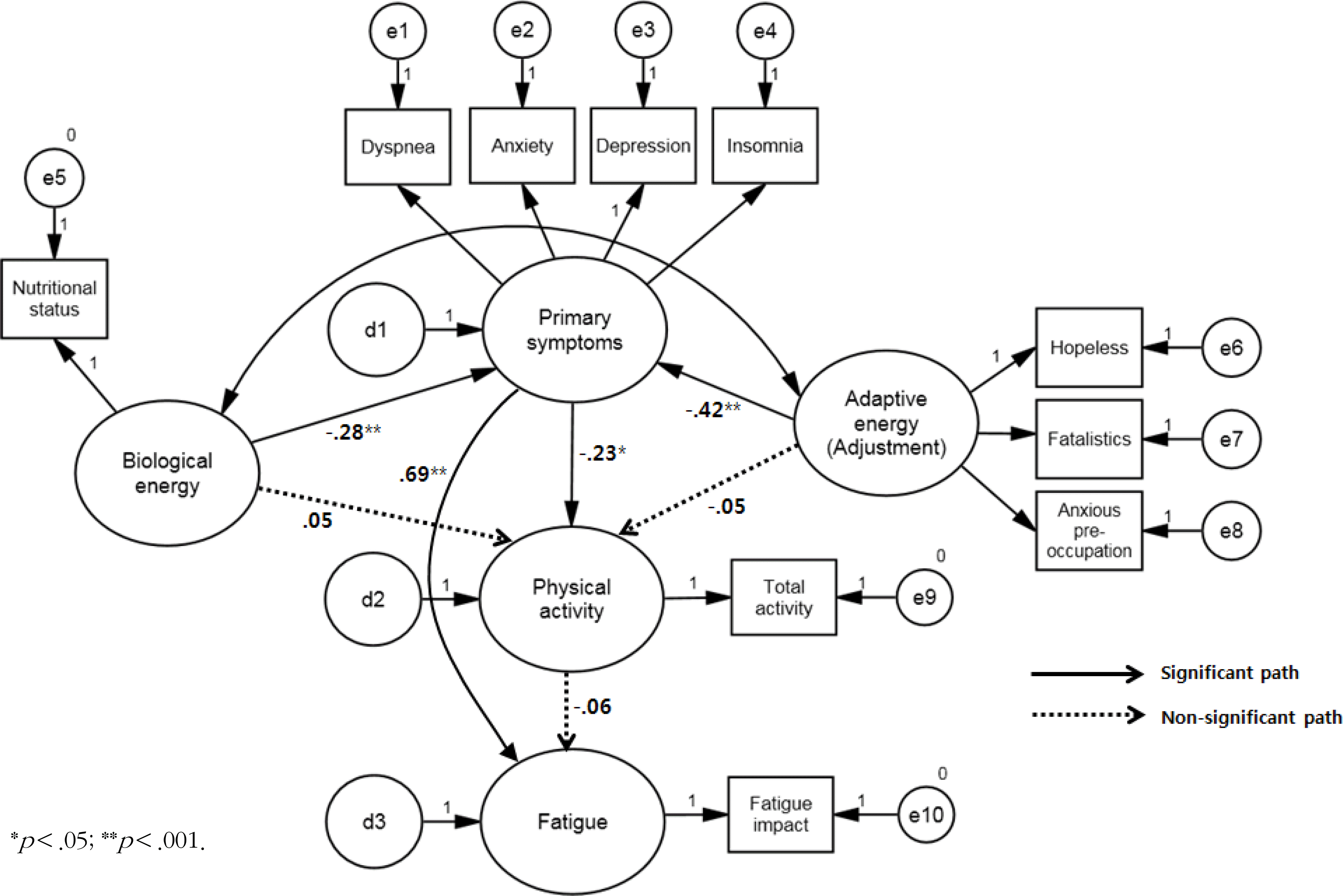Abstract
Purpose
The purpose of this study was to test a Winningham's psychobiologic entropy model (PEM) on cancer related fatigue (CRF) among patients with solid tumors.
Methods
Participants consisted of 213 patients with solid tumors recruited from December, 2012 through June, 2013, in a university hospital, in Hwasun, South Korea. Primary symptoms, adjustment, physical activity, status of nutrition and fatigue were measured using structured questionnaires. Collected data were analyzed using SPSS 21.0 and AMOS 21.0 programs.
Results
The modified model tested provided a reasonable fit to the data (x2=65.80 [df=30, p<.001], TLI=.92, CFI=.95, RMSEA=.08, SRMR=.07). Primary symptoms (dyspnea, anxiety, depression and insomnia) had direct positive effects on CRF. Adjustment and status of nutrition showed indirect negative effects on CRF. However, the impact of physical activity was not significant. These variables explained 49.2% of the variance of CRF among solid tumor patients.
Go to : 
REFERENCES
1.Mock V., Atkinson A., Barsevick AM., Berger AM., Cimprich B., Eisenberger MA, et al. Cancer-related fatigue. Clinical practice guidelines in oncology. Journal of the National Comprehensive Cancer Network: JNCCN. 2007. 5(10):1054–78.
2.Hofman M., Ryan JL., Figueroa-Moseley CD., Jean-Pierre P., Morrow GR. Cancer-related fatigue: the scale of the problem. Oncologist. 2007. 12(1):4–10. http://dx.doi.org/10.1634/theoncologist.12-S1-4.

3.Horneber M., Fischer I., Dimeo F., Rüffer JU., Weis J. Cancer-related fatigue: epidemiology, pathogenesis, diagnosis and treatment. Deutsches Ärzteblatt International. 2012. 109(9):161–72. http://dx.doi.org/10.3238/arztebl.2012.0161.
4.Winningham ML., Nail LM., Burke MB., Brophy L., Cimprich B., Jones LS, et al. Fatigue and the cancer experience: the state of the knowledge. Oncology Nursing Forum. 1994. 21(1):23–36.
5.Bower JE., Lamkin DM. Inflammation and cancer-related fatigue: mechanism, contributing factors, and treatment implications. Brain, Behavior, and Immunity. 2013. 30:48–S57. http://dx.doi.org/10.1016/j.bbi.2012.06.011.
6.AI-Majid S., Gray P. A biobehavioral model for the study of exercise interventions in cancer-related fatigue. Biological Research for Nursing. 2009. 10(4):381–91.

7.Choi JY., Kang HS. Influencing factors for fatigue in cancer patients. Journal of Korean Academy Nursing. 2007. 37(3):365–72. http://dx.doi.org/10.1177/1099800408324431.

8.Pearson EJ., Morris ME., McKinstry CE. Cancer-related fatigue: a survey of health practitioner knowledge and practice. Supportive Care in Cancer. 2015. ;[Epub ahead of print].

9.Winningham M. The role of exercise in cancer therapy. Eistinger M, Watson RW, editors. Exercise and disease. Boca Raton, FL: CRC Press;1992. p. 63–70.

10.Zordan R., Manitta V., Nandurkar H., Cole-Sinclair M., Philip J. Prevalence and predictors of fatigue in haemo-oncological patients. Internal Medicine Journal. 2014. 44(10):1013–7. http://dx.doi.org/10.1111/imj.12517.

11.Nail LM., Winningham ML. Fatigue and weakness in cancer patients: the symptom experience. Seminars in Oncology Nursing. 1995. 11(4):272–8.

12.Husain N., Cruickshank K., Husain M., Khan S., Tomenson B., Rahman A. Social stress and depression during pregnancy and in the postnatal period in British Pakistani mothers: a cohort study. Journal of Affective Disorders. 2012. 140(3):268–76. http://dx.doi.org/10.1016/j.jad.2012.02.009.

13.Bentler PM., Chou CP. Practical issues in structural modeling. Sociological Methods and Research. 1987. 15(1):78–117. http://dx.doi.org/10.1177/0049124187016001004.

14.Kim YJ., Kim JY., Choi IR., Kim MW., Rhodes VA. The index of nausea, vomiting, and retching(Korean translation). Journal of Korean Academy Adult Nursing. 2000. 12(2):278–85.
15.Zigmond AS., Snaith RP. The hospital anxiety and depression scale. British Medical Journal. 1983. 67(6):361–70. 16. Shin JS, Lee YB. The effects of social supports on psychosocial well-being of the unemployed. Korean Journal of Social Welfare. 1999. 37:241–69.

17.Cho YW., Song ML., Morin CM. Validation of a Korean version of the insomnia severity index. Journal of Clinical Neurology. 2014. 10(3):210–5. http://dx.doi.org/10.3988/jcn.2014.10.3.210.

18.Bauer J., Capra S., Ferguson M. Use of the scored patient-generated subjective global assessment(PG-SGA) as a nutrition assessment tool in patients with cancer. European Journal of Clinical Nutrition. 2002. 56:779–85.
19.Lee MS. Relationship between breast cancer and coping style or emotional adaptation [master thesis]. Seoul: Seoul National University;1997.
20.Oh JY., Yang YJ., Kim BS., Kang JH. Validity and reliability of Korean version of International Physical Activity Questionnaire (IPAQ) short form. Korean Journal of Family Medicine. 2007. 28(7):532–41. http://dx.doi.org/10.4082/kjfm.2012.33.3.144.
21.Mendoza TR., Wang XS., Cleeland CS., Morrissey M., Johnson BA., Wendt JK, et al. The rapid assessment of fatigue severity in cancer patients: use of the brief fatigue inventory. Cancer. 1999. 85(5):1186–96.
22.Valentine AD., Meyers CA. Cognitive and mood disturbance as causes and symptoms of fatigue in cancer patients. Cancer. 2001. 92(6 Suppl):1694–8.

23.Porock D., Beshears B., Hilton P., Anderson C. Nutritional, functional, an emotional characteristics related to fatigue in patients during and after biochemotherapy. Oncology Nursing Forum. 2005. 32(3):661–7.
24.Mitchell SA., Beck SL., Hood AE., Moore K., Tanner ER. Putting evidence into practice: evidence-based interventions for fatigue during and following cancer and its treatment. Clinical Journal of Oncology Nursing. 2007. 11(1):99–113. http://dx.doi.org/10.1188/07.CJON.99-113.

25.Cramp F., Byron-Daniel J. Exercise for the management of cancer-related fatigue in adults. The Cochrane Database of Systematic Reviews. 2012. 11:CD006145. http://dx.doi.org/10.1002/14651858.CD006145.pub3.

26.Seo YM., Oh HS., Seo WS., Kim HS. Comprehensive predictors of fatigue for cancer patients. Journal of Korean Academy Nursing. 2006. 36(7):1224–31.

27.Dirksen SR., Belyea MJ., Epstein DR. Fatigue-based subgroups of breast cancer survivors with insomnia. Cancer Nursing. 2009. 32(5):404–11. http://dx.doi.org/10.1097/NCC.0b013e3181a5d05e.

28.Guest DD., Evans EM., Rogers LQ. Diet components associated with perceived fatigue in breast cancer survivors. European Journal of Cancer Care. 2013. 22(1):51–9. http://dx.doi.org/10.1111/j.1365-2354.2012.01368.x.

Go to : 
Table 1.
Descriptive Statistics of the Observed Variables (N=202)
Table 2.
Goodness of Model Fit Indices (N=202)
| Model | df | x2 (p) | TLI | CFI | RMSEA | SRMR |
|---|---|---|---|---|---|---|
| Criterion | ≥.00 | Low (≥.05) | ≥.90 | ≥.90 | ≤.08 | ≤.08 |
| Hypothetical model | 31 | 164.18 (<.001) | .71 | .80 | .15 | .16 |
| Modified model | 30 | 65.80 (<.001) | .92 | .95 | .08 | .07 |
Table 3.
Effects of Predictive Variables in the Modified Model (N=202)




 PDF
PDF ePub
ePub Citation
Citation Print
Print




 XML Download
XML Download